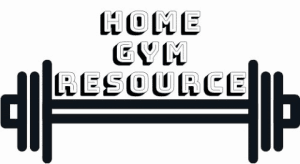Creating a home gym is an exciting endeavor that allows you to exercise in the comfort of your own home. The flooring sets the foundation for your workouts, providing comfort, support, and safety. In this article, we’ll explore the various options available for home weight room flooring and provide insights to help you make an informed decision.
Don’t want to do all the research yourself? Here is an article that reveals the best type of gym flooring for your specific needs.
Contents
Key Takeaways
Before we dive into the world of home gym flooring, here are the key takeaways to keep in mind:
- Consider the type of exercises and equipment you’ll be using in your home or garage gym to determine the flooring that best suits your needs: For heavy weightlifting you need another type of flooring than for a treadmill or doing yoga.
- Evaluate factors such as durability, impact resistance, ease of maintenance, and budget when selecting home gym flooring. Rubber is very durable and easy to maintain but the most expensive. Vinyl is a more affordable alternative where extreme durability isn’t necessary. For weightlifting, you want more durability even if it costs more. For doing cardio and yoga, vinyl is fine.
- Explore shapes like tiles, interlocking tiles, and rolls. Large rolls of gym flooring are usually the best since they’re easy to clean, don’t have many seams, and are a bit more affordable than tiles. However, they’re very heavy so more difficult to install.
- Consider noise: Rubber is better at damping impact noises than vinyl. Foam is even better but lacks the durability to handle repeated impacts over time.
- Choose the right thickness for the job: Gym flooring has to protect your floor underneath, your equipment and also your joints. Thicker mats have more noise and impact damping. This is good for high-impact and very heavy weightlifting workouts. If your gym flooring is too thin, you might lack some damping and still damage your floor or equipment. The right thickness depends on your activities.
Now, let’s dive into the details and find out how to pick the ideal home gym flooring for your unique requirements.
Recommendations For Different Home Gyms
Before we get into the rest of the article, here are some quick recommendations for some common situations. Keep in mind, this whole article is focused on flooring for home and garage gyms. For commercial gyms things are a bit different.
- Cardio and High-Impact Workouts: For exercises involving cardio and high-impact movements, rubber flooring is an excellent choice. Its shock absorption and resilience reduce the strain on joints. Foam tiles can also provide cushioning and impact damping.
- Rubber Rolls are the best but tiles are OK too if installed properly. Vinyl rolls are a cheaper alternative but will wear faster.
- If you only have a cardio machine and don’t need the other space to be floored, just a mat under the machine is fine.
- A thickness of 8mm to 10mm (0.31″ – 0.4″) is typically suitable for providing cushioning and reducing the impact on your joints. This thickness is also good for cardio machines.
- Weightlifting and Strength Training: When it comes to weightlifting and strength training, opt for rubber flooring. Its stability, durability, and impact resistance make it ideal for heavy equipment and intense workouts. Rubber mats offer excellent grip and shock absorption.
- It’s best to floor the whole gym so all the equipment is protected as well as the floor.
- A thickness of 12mm to 20mm is recommended for most weightlifting areas. If you lift very heavy (300lbs+) or drop weights from overhead, 25-40 mm is better. However, thicker rubber doesn’t usually come in rolls. You’ll have to use tiles if you want more than 3/4″ thickness.
- Yoga, Pilates, and Flexibility Exercises: foam flooring is a suitable option for activities that require stability and support. It provides a stable surface with slight cushioning, promoting balance and alignment during exercises.
- A thickness of 6mm to 8mm is typically sufficient to provide a firm and stable surface without compromising comfort.
- Also, usually it’s not necessary to floor the whole home gym for this type of exercise. A smaller mat you can unroll when necessary is often more practical since you keep the space free for other activities.
Keep reading if you want more information before making a decision.
Match Your Gym Flooring to Your Gym Use
The first step in choosing the right home gym flooring is to understand your specific workout needs. Consider the type of exercises you’ll be performing and the equipment you’ll be using.
Different flooring materials offer various benefits based on your fitness routine. Let’s explore some common workout categories and the suitable flooring options for each:
Or click here if you just want to find the best flooring for most home workout rooms.
Cardio and High-Impact Workouts
If you enjoy cardio exercises or engage in high-impact workouts like jumping jacks or plyometrics, it’s crucial to choose flooring that offers shock absorption and cushioning.
Rubber flooring, such as rubber mats or rolls, is an excellent choice. It provides a resilient surface that absorbs impact, reducing strain on your joints. Alternatively, foam tiles offer cushioning and impact resistance, creating a comfortable workout space that minimizes the risk of injuries.
For underneath cardio machines, rubber is best but vinyl also works well. Foam is too soft for under heavy cardio equipment like treadmills.
Read more here about the purposes of a workout floor.
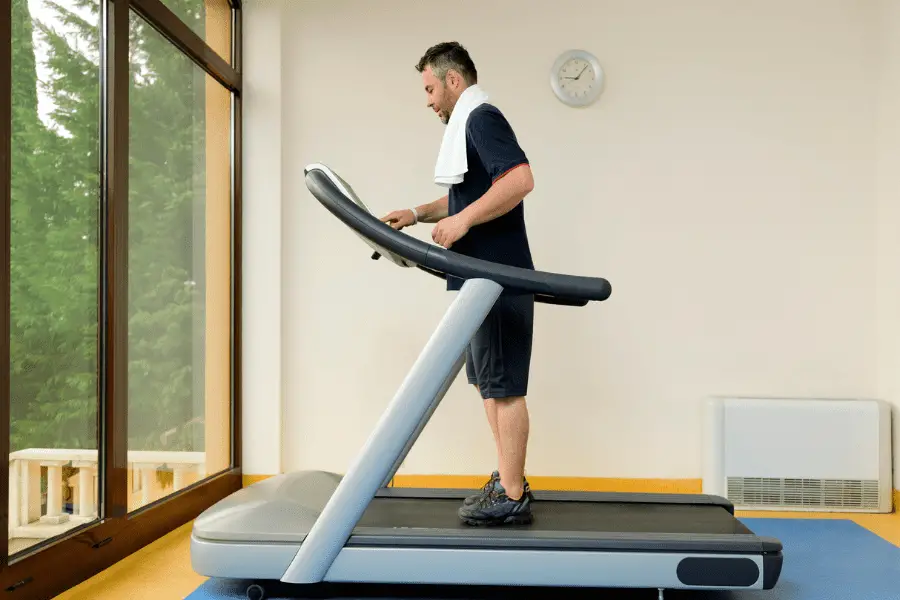
Weightlifting and Strength Training
For weightlifting or strength training exercises that involve heavy equipment and weights, opt for flooring that offers stability, durability, and protection.
Rubber flooring, especially interlocking rubber tiles, is an ideal option. It provides a sturdy and impact-resistant surface that withstands the demands of weightlifting activities.
Rubber mats offer excellent grip and shock absorption, ensuring a safe and secure environment for your lifting sessions. They are also best at absorbing noises and vibrations so your neighbors and other household members aren’t bothered as much by your workouts. Rubber is the best when weights are involved.
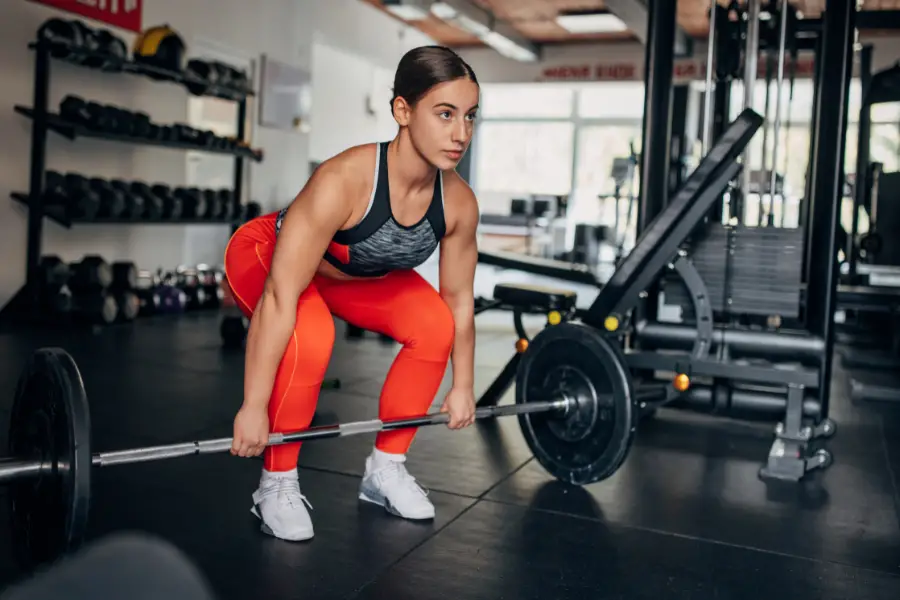
Yoga, Pilates, Bodyweight and Flexibility Exercises
If your fitness routine includes yoga, Pilates, or exercises that require stability and support, you need flooring that offers comfort and firmness while still being comfortable for your bare feet, hands, and body.
Vinyl can work here although thin foam (1/2″ or less) will also work fine. Thicker foam can be a little too soft unless you go for high-density foam.
This type of exercise doesn’t create a lot of impact so there is not much need for impact-resistance and damping. The faster-wearing properties of foam are o less of a concern when there are no heavy weights or equipment involved.
Exploring Home and Garage Gym Flooring Options
We discussed the importance of matching your gym flooring to your specific workout needs. Now, let’s delve into the different home gym flooring options available and explore their features and benefits.
Gym Flooring Materials
Rubber Flooring
Rubber flooring is a popular choice for garage gyms due to its durability and versatility. It offers excellent shock absorption and impact resistance, making it suitable for high-impact workouts and heavy equipment. Rubber gym flooring comes in various forms, including mats, rolls, or interlocking tiles.
These options allow for easy installation and customization, ensuring a perfect fit for your space. With its ability to withstand the demands of intense workouts, rubber flooring provides a stable and comfortable surface that protects both your body and your equipment.
Rubber is the best home gym flooring material in general. Here’s an explanation why rubber is so good for workout mats and when to choose something else.
Pros:
- Excellent shock absorption and impact resistance, making it ideal for high-impact workouts and heavy equipment.
- Provides a stable and secure surface, reducing the risk of slips and falls during exercises.
- Durable and long-lasting, with the ability to withstand the demands of intense workouts and constant foot traffic.
- Reduces noise and vibrations, creating a quieter and more pleasant workout environment.
- Easy to clean and maintain, requiring simple sweeping and occasional mopping.
- Offers a wide range of design options, including various colors and finishes, allowing for customization and personalization.
- Provides good grip and traction, promoting safety during exercises.
Cons:
- Can have a strong rubber odor initially, although it typically dissipates over time.
- May be more expensive compared to other flooring options, especially for high-quality rubber materials.
- Can be heavy and difficult to install, especially for larger gym spaces.
- Some rubber flooring options may require adhesive for installation, which can add to the complexity and cost.
- Can show scuff marks and indentations over time, although these are often cosmetic and do not affect performance.
Need more information about home gym flooring? Start here.
Vinyl Flooring
Vinyl flooring is another fantastic option for home gyms, offering durability and ease of maintenance. It is known for its water resistance, making it ideal for spaces where spills or sweat may occur.
Vinyl gym flooring comes in different styles, including planks or modular grid-loc tiles, allowing you to create a visually appealing and functional gym space. Beyond its practicality, vinyl flooring provides a comfortable underfoot feel and moderate shock absorption. It’s easy to clean and maintain, ensuring a long-lasting and hygienic flooring solution.
Vinyl does a lot of things well, however, it’s not as durable and noise-damping as rubber is. It is cheaper though.
Pros:
- Durable and resistant to scratches, stains, and water, ensuring longevity and easy maintenance.
- Provides a comfortable and firm surface for workouts, offering stability and support.
- Easy to clean with regular sweeping and occasional mopping, making it a low-maintenance option.
- Offers a wide range of design options, including wood or stone patterns, allowing for a visually appealing gym space.
- Water-resistant properties make it suitable for areas prone to spills or sweat, such as home gyms or workout rooms.
- Can be more budget-friendly compared to some other flooring options, offering cost-effective solutions for home gyms.
- Provides moderate shock absorption, balancing cushioning with stability during workouts.
Cons:
- May have a slight chemical odor initially, but it typically dissipates over time.
- Can be susceptible to damage from sharp objects or heavy weights if not handled with care.
- Depending on the quality, vinyl flooring may show signs of wear and tear over time, such as scratches or fading.
- May not offer as much impact resistance as rubber flooring for high-impact exercises.
- Installation can require adhesive or professional assistance, increasing complexity and cost compared to some other options.
- In very high-temperature environments, vinyl flooring may be prone to warping or discoloration.
Foam
For those seeking cushioned and impact-absorbing flooring, foam tiles are an excellent choice. These tiles provide a soft and forgiving surface, reducing the risk of injuries during intense workouts. Foam tiles are available in various thicknesses and densities, allowing you to customize the level of cushioning to your liking.
They are lightweight, cheap, portable, and easy to install, making them a flexible option for different workout areas. Additionally, foam tiles offer soundproofing benefits, making them suitable for apartments or shared spaces where noise reduction is essential.
However, foam tiles don’t last very long under heavy impacts and start looking tattered pretty quickly.
Pros:
- Provides excellent cushioning and impact absorption, reducing the risk of injuries during workouts.
- Soft and comfortable surface that is gentle on joints and provides a forgiving feel for exercises.
- Lightweight and portable, allowing for easy installation, reconfiguration, or transportation if needed.
- Easy to clean with mild detergents and a damp cloth, making maintenance hassle-free.
- Offers soundproofing benefits, reducing noise and vibrations during workouts.
- Can be more cost-effective compared to some other gym flooring options.
- Interlocking foam tiles provide customization options and flexibility in shaping your gym space.
Cons:
- Less durable compared to rubber or vinyl flooring options, with the potential for wear and tear over time.
- May indent or compress under heavy equipment or weights, requiring caution and proper weight distribution.
- Susceptible to damage from sharp objects or dragging heavy equipment.
- Can absorb sweat or spills, requiring more attention for cleaning and potential odor management.
- Limited design options compared to other flooring materials.
- May not provide as much stability for exercises that require a firm and stable surface.
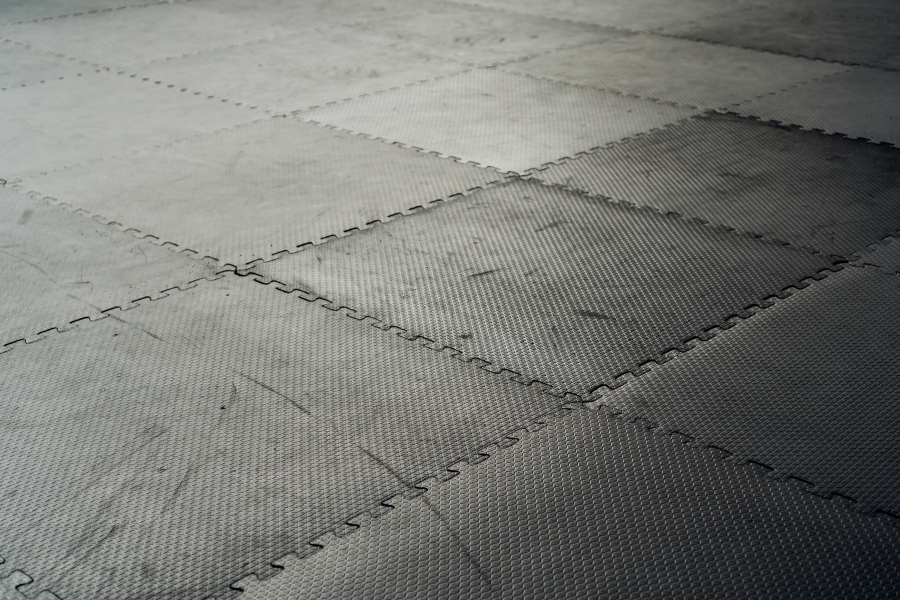
Gym Flooring Shapes
Of course, pretty much all gym flooring comes in a square or rectangular shape. There are some you should know though.
Rolls
Large rolls are generally the best choice of shape for home gym flooring. These mats cover a large area in one go and while they’re heavy, they’re usually more affordable than tiles and they’re easy to clean.
You’ll also have way fewer seams with rolls which is a big benefit. Fewer seams means easier cleaning, a cleaner look and fewer tripping hazards.
Tiles
Below we’ll go into interlocking tiles but there are also normal gym flooring tiles without puzzle edges. Usually, these are thick, rough rubber tiles, not always meant for gym purposes. These tiles are good in spots where you need a bit extra protection and damping.
For example, you have a normal gym floor but you’re afraid that dropping a heavy barbell repeatedly is still going to damage something or it makes too much noise. Putting a few extra tiles in the spots where the weight plates hit the floor makes a lot of sense. Just put them down when necessary and get the tiles out of the way afterwards.
I wouldn’t recommend using these tiles for the whole home gym floor. Rolls are better, usually cheaper and leave you with fewer seams.
Interlocking Flooring
Interlocking gym flooring provides a versatile and convenient option for home gyms. These tiles feature interlocking edges, allowing for easy installation and customization. Interlocking flooring is available in materials such as rubber, rubber-topped foam, or foam, offering flexibility in choosing the right type for your specific needs.
The interlocking design ensures a secure and stable surface, providing a safe environment for your workouts. Whether you prefer the resilience of rubber or the cushioning of foam, interlocking tiles allow you to create a personalized and comfortable gym space.
As you explore these flooring options, consider factors such as durability, maintenance requirements, and budget to make an informed decision. Samples and expert advice can also assist you in choosing the flooring that best suits your home gym.
Factors for Choosing the Perfect Home Gym Flooring
Now that we’ve explored the different home gym flooring options available, let’s dive into the factors you should consider when making your final decision. These factors will help you choose the perfect flooring that meets your specific needs and preferences.
Durability and Longevity
When selecting home gym flooring, durability is crucial. Your flooring should be able to withstand the demands of your workouts and maintain its quality over time. Rubber flooring is known for its exceptional durability, making it a popular choice for home gyms. It’s also the most expensive.
It can handle heavy equipment, high-impact exercises, and constant foot traffic without wearing down easily. Vinyl flooring is also durable and resistant to scratches, stains, and water, ensuring a long-lasting investment although not as long as rubber.
Foam usually doesn’t last very long with heavy use.
Maintenance and Ease of Cleaning
Consider the maintenance requirements of your chosen flooring. Home gym flooring should be easy to clean and maintain to ensure a hygienic workout environment. Rubber and vinyl flooring are generally easy to clean with regular sweeping and occasional mopping.
Foam tiles may require more attention, as they can absorb sweat and spills, but they can still be cleaned with mild detergents and a damp cloth. Choose flooring that fits your lifestyle and cleaning preferences to make your fitness space hassle-free.
Budget and Cost-Effectiveness
Your budget is an important factor to consider when selecting home gym flooring. Different materials come with varying price ranges, and it’s essential to choose an option that aligns with your financial considerations.
Rubber flooring tends to be more expensive but offers long-term value due to its durability. Vinyl flooring and foam tiles are often more budget-friendly alternatives without compromising on quality and functionality. Determine your budget range and explore options that provide the best balance between cost and performance.
Just so you have an idea, here is a rundown of much the different types of flooring cost:
- Rubber Rolls: Large rubber gym mats are a bit cheaper than rubber gym tiles at an average of $4,58 per square foot. The prices for rubber gym mats range from $3,13 to $7,13 per square foot.
- Rubber Gym Tiles: Rubber gym puzzle tiles cost a little over $5 per square foot with prices ranging from $2.17 to over $11 per square foot.
- Foam Gym Tiles: Foam gym flooring costs from $0,73 to $2,92. The average price of foam tiles is $1,65 per square foot.
- Rubber-Topped Gym Tiles: Prices range from $2,50 to $5,83 per square foot. The average price of rubber-topped foam tiles is $3,34.
Find an in-depth article of how much the different types of gym flooring cost here.
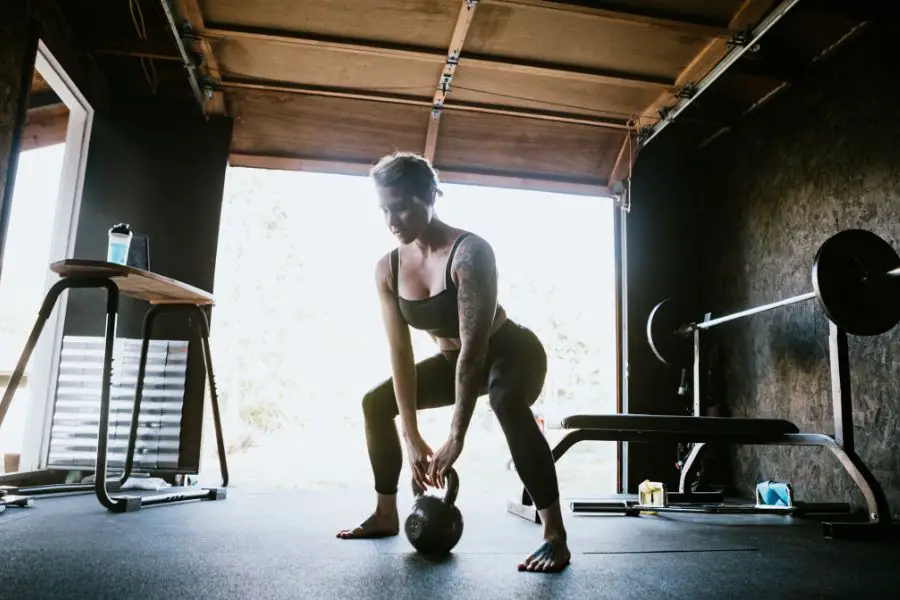
Safety and Comfort
Safety should be a top priority when selecting home gym flooring. Look for flooring that provides adequate traction and grip to prevent slips and falls during workouts. Rubber flooring, with its textured surface, offers excellent slip resistance.
Foam tiles, on the other hand, provide cushioning and impact absorption, reducing the risk of injuries but can only be used for light exercises. Ensure your flooring choice promotes a safe and comfortable exercise experience.
This study shows that more than 25% of injuries in gyms are caused by trips and falls. Getting the right flooring provides more grip and can so help reduce injury risk.
Size and Thickness
When picking the specific rolls or tiles, pay attention to the size of your gym or the size of the workout area that needs matting. Sometimes rolls are only available in certain sizes that don’t really work for your space.
For example, if your gym is 8′ long but the rolls you picked are only available in 6′ lengths, this isn’t optimal. You’ll have to cut a second roll somewhere and fit it in perfectly. This creates extra seams you don’t want and is just more complicated.
The thickness is also an important choice to make. This is related to impact resistance and longevity but it’s worth mentioning separately. The thickness has an impact on the amount of impact the flooring can take, how much noise is absorbed, and how well the floor underneath is protected.
In most cases, 3/4″ thick rubber mats work well although for super heavy weightlifting going up to 1″+ rubber is worth it. Read more on recommended gym flooring thickness here.
Thicker flooring, especially rubber reduces impact noise. So the sound of dropping the dumbbells after a set for example. Going thicker than necessary costs more and is harder to install but has no drawbacks other than that.
Aesthetics and Design
While functionality is crucial, the aesthetics of your home gym space also matter. Choose flooring that enhances the overall ambiance of your gym and complements your personal style. Vinyl flooring offers a wide range of designs, including wood or stone patterns, allowing you to create a visually appealing space.
Rubber flooring is available in various colors and finishes although not nearly as much as vinyl, giving you flexibility in customizing the look of your gym. Consider the design options available and select flooring that inspires and motivates you during your workouts.
How to Choose the Right Gym Flooring for You
Now that you have a good understanding of the different types of home gym flooring available and the factors to consider, let’s dive deeper into the process of choosing the right gym flooring for your specific needs. Here are some essential steps to help you make an informed decision:
1. Assess Your Workout Needs
Begin by evaluating your workout routine and the specific activities you’ll be engaging in. Consider the types of exercises, equipment, and intensity levels involved. Are you focused on cardio, weightlifting, yoga, or a combination of various workouts? Understanding your workout needs will help you determine the type of flooring that will best support your fitness regimen.

2. Set Your Priorities
Identify your priorities when it comes to gym flooring. What factors are most important to you? Is it durability, shock absorption, ease of maintenance, or budget? Prioritize the factors that align with your fitness goals and preferences. This will help you narrow down your options and make the selection process easier.
3. Research and Explore Options
Take the time to research and explore the different types of gym flooring available. Visit websites, read reviews, and seek expert opinions. Learn about the pros and cons of each flooring material and how they align with your priorities. This research will provide valuable insights into the features and benefits of various flooring options.
4. Request Samples
To get a better sense of how different gym flooring materials look and feel, request samples from manufacturers or suppliers. Samples allow you to see the colors, textures, and quality of the flooring up close. By physically examining the samples, you can make a more informed decision and visualize how the flooring will look in your home gym.
5. Consider Long-Term Value
While the upfront cost is important, consider the long-term value of the gym flooring you choose. Evaluate the durability, lifespan, and maintenance requirements of each option. Investing in higher-quality flooring might initially be more expensive but can save you money in the long run by reducing the need for frequent replacements or repairs.
6. Trust Your Instincts
Lastly, trust your instincts. After conducting thorough research, considering your priorities, and seeking advice, go with the gym flooring option that feels right for you. Your intuition, combined with the information you’ve gathered, will lead you to the flooring that suits your unique requirements and personal style.
By following these steps, you’ll be well-equipped to choose the right gym flooring for your home gym. Remember, your gym flooring sets the stage for your fitness journey and plays a significant role in your overall workout experience. So take your time, weigh your options, and select the flooring that will inspire you to achieve your fitness goals.
Now that you have the knowledge and guidance to make an informed decision, it’s time to turn your home gym dreams into reality. Choose the perfect gym flooring that matches your style, supports your workouts, and helps you create the fitness haven you’ve always envisioned. Get ready to elevate your fitness space and embark on a journey of health, strength, and well-being.
